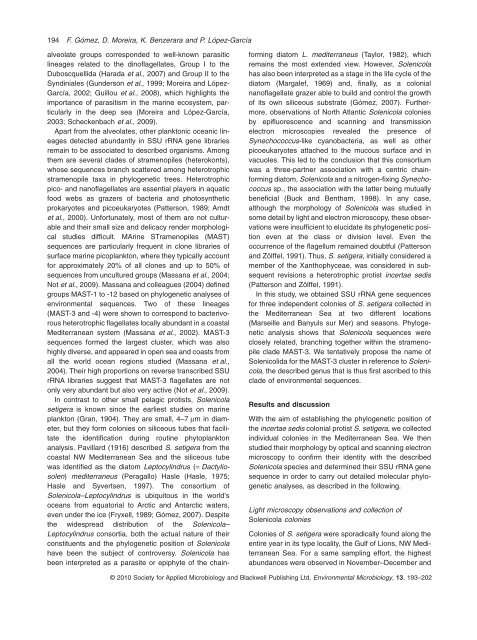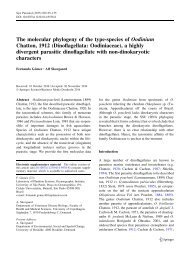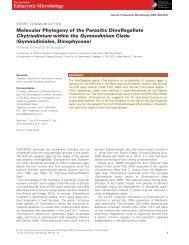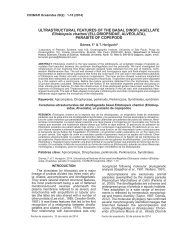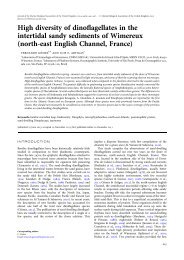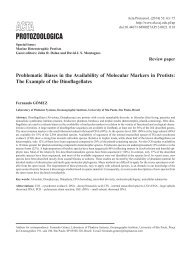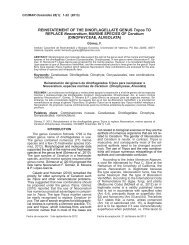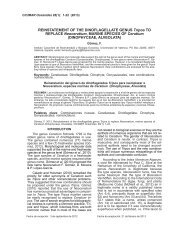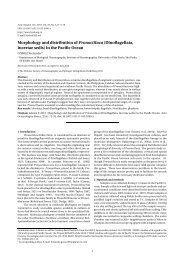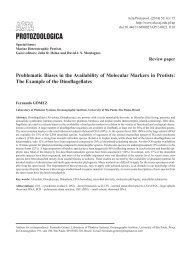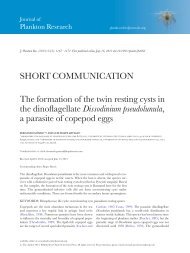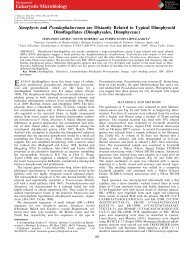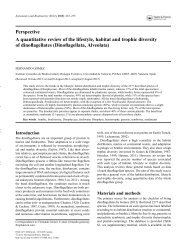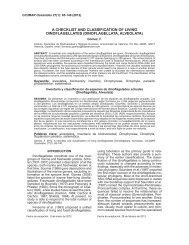Solenicola setigera is the first characterized memberof the abundant and cosmopolitan uncultured marine stramenopile group MAST-3
Culture-independent molecular methods based on the amplification, cloning and sequencing of smallsubunit (SSU) rRNA genes are a powerful tool to study the diversity of prokaryotic and eukaryotic microorganisms for which morphological features are not conspicuous. In recent years, molecular data from environmental surveys have revealed several clades of protists lacking cultured and/or described members. Among them are various clades of marine stramenopiles (heterokonts), which are thought to play an essential ecological role as grazers, being abundant and distributed in oceans worldwide. In this work, we show that Solenicola setigera, a distinctive widespread colonial marine protist, is a member of the environmental clade MArine STramenopile 3 (MAST-3). Solenicola is generally considered as a parasite or an epiphyte of the diatom Leptocylindrus mediterraneus. So far, the ultrastructural, morphological and ecological data available were insufficient to elucidate its phylogenetic position, even at the division or class level. We determined SSU rRNA gene sequences of S. setigera specimens sampled from different locations and seasons in the type locality, the Gulf of Lions, France. They were closely related, though not identical, which, together with morphological differences under electron microscopy, suggest the occurrence of several species. Solenicola sequences were well nested within the MAST-3 clade in phylogenetic trees. Since Solenicola is the first identified member of this abundant marine clade, we propose the name Solenicolida for the MAST-3 phylogenetic group.
Culture-independent molecular methods based on
the amplification, cloning and sequencing of smallsubunit
(SSU) rRNA genes are a powerful tool to
study the diversity of prokaryotic and eukaryotic
microorganisms for which morphological features are
not conspicuous. In recent years, molecular data from
environmental surveys have revealed several clades
of protists lacking cultured and/or described
members. Among them are various clades of marine
stramenopiles (heterokonts), which are thought to
play an essential ecological role as grazers, being
abundant and distributed in oceans worldwide. In this
work, we show that Solenicola setigera, a distinctive
widespread colonial marine protist, is a member of
the environmental clade MArine STramenopile 3
(MAST-3). Solenicola is generally considered as a
parasite or an epiphyte of the diatom Leptocylindrus
mediterraneus. So far, the ultrastructural, morphological
and ecological data available were insufficient
to elucidate its phylogenetic position, even at the division
or class level. We determined SSU rRNA gene
sequences of S. setigera specimens sampled from
different locations and seasons in the type locality,
the Gulf of Lions, France. They were closely related,
though not identical, which, together with morphological
differences under electron microscopy,
suggest the occurrence of several species. Solenicola
sequences were well nested within the MAST-3
clade in phylogenetic trees. Since Solenicola is the
first identified member of this abundant marine clade,
we propose the name Solenicolida for the MAST-3
phylogenetic group.
Create successful ePaper yourself
Turn your PDF publications into a flip-book with our unique Google optimized e-Paper software.
194 F. Gómez, D. Moreira, K. Benzerara <strong>and</strong> P. López-García<br />
alveolate <strong>group</strong>s corresponded to well-known parasitic<br />
lineages related to <strong>the</strong> dinoflagellates, Group I to <strong>the</strong><br />
Duboscquellida (Harada et al., 2007) <strong>and</strong> Group II to <strong>the</strong><br />
Syndiniales (Gunderson et al., 1999; Moreira <strong>and</strong> López-<br />
García, 2002; Guillou et al., 2008), which highlights <strong>the</strong><br />
importance of parasit<strong>is</strong>m in <strong>the</strong> <strong>marine</strong> ecosystem, particularly<br />
in <strong>the</strong> deep sea (Moreira <strong>and</strong> López-García,<br />
2003; Scheckenbach et al., 2009).<br />
Apart from <strong>the</strong> alveolates, o<strong>the</strong>r planktonic oceanic lineages<br />
detected <strong>abundant</strong>ly in SSU rRNA gene libraries<br />
remain to be associated to described organ<strong>is</strong>ms. Among<br />
<strong>the</strong>m are several clades of <strong>stramenopile</strong>s (heterokonts),<br />
whose sequences branch scattered among heterotrophic<br />
<strong>stramenopile</strong> taxa in phylogenetic trees. Heterotrophic<br />
pico- <strong>and</strong> nanoflagellates are essential players in aquatic<br />
food webs as grazers of bacteria <strong>and</strong> photosyn<strong>the</strong>tic<br />
prokaryotes <strong>and</strong> picoeukaryotes (Patterson, 1989; Arndt<br />
et al., 2000). Unfortunately, most of <strong>the</strong>m are not culturable<br />
<strong>and</strong> <strong>the</strong>ir small size <strong>and</strong> delicacy render morphological<br />
studies difficult. MArine STramenopiles (<strong>MAST</strong>)<br />
sequences are particularly frequent in clone libraries of<br />
surface <strong>marine</strong> picoplankton, where <strong>the</strong>y typically account<br />
for approximately 20% of all clones <strong>and</strong> up to 50% of<br />
sequences from <strong>uncultured</strong> <strong>group</strong>s (Massana et al., 2004;<br />
Not et al., 2009). Massana <strong>and</strong> colleagues (2004) defined<br />
<strong>group</strong>s <strong>MAST</strong>-1 to -12 based on phylogenetic analyses of<br />
environmental sequences. Two of <strong>the</strong>se lineages<br />
(<strong>MAST</strong>-3 <strong>and</strong> -4) were shown to correspond to bacterivorous<br />
heterotrophic flagellates locally <strong>abundant</strong> in a coastal<br />
Mediterranean system (Massana et al., 2002). <strong>MAST</strong>-3<br />
sequences formed <strong>the</strong> largest cluster, which was also<br />
highly diverse, <strong>and</strong> appeared in open sea <strong>and</strong> coasts from<br />
all <strong>the</strong> world ocean regions studied (Massana et al.,<br />
2004). Their high proportions on reverse transcribed SSU<br />
rRNA libraries suggest that <strong>MAST</strong>-3 flagellates are not<br />
only very <strong>abundant</strong> but also very active (Not et al., 2009).<br />
In contrast to o<strong>the</strong>r small pelagic prot<strong>is</strong>ts, <strong>Solenicola</strong><br />
<strong>setigera</strong> <strong>is</strong> known since <strong>the</strong> earliest studies on <strong>marine</strong><br />
plankton (Gran, 1904). They are small, 4–7 mm in diameter,<br />
but <strong>the</strong>y form colonies on siliceous tubes that facilitate<br />
<strong>the</strong> identification during routine phytoplankton<br />
analys<strong>is</strong>. Pavillard (1916) described S. <strong>setigera</strong> from <strong>the</strong><br />
coastal NW Mediterranean Sea <strong>and</strong> <strong>the</strong> siliceous tube<br />
was identified as <strong>the</strong> diatom Leptocylindrus (= Dactyliosolen)<br />
mediterraneus (Peragallo) Hasle (Hasle, 1975;<br />
Hasle <strong>and</strong> Syvertsen, 1997). The consortium of<br />
<strong>Solenicola</strong>–Leptocylindrus <strong>is</strong> ubiquitous in <strong>the</strong> world’s<br />
oceans from equatorial to Arctic <strong>and</strong> Antarctic waters,<br />
even under <strong>the</strong> ice (Fryxell, 1989; Gómez, 2007). Despite<br />
<strong>the</strong> widespread d<strong>is</strong>tribution of <strong>the</strong> <strong>Solenicola</strong>–<br />
Leptocylindrus consortia, both <strong>the</strong> actual nature of <strong>the</strong>ir<br />
constituents <strong>and</strong> <strong>the</strong> phylogenetic position of <strong>Solenicola</strong><br />
have been <strong>the</strong> subject of controversy. <strong>Solenicola</strong> has<br />
been interpreted as a parasite or epiphyte of <strong>the</strong> chainforming<br />
diatom L. mediterraneus (Taylor, 1982), which<br />
remains <strong>the</strong> most extended view. However, <strong>Solenicola</strong><br />
has also been interpreted as a stage in <strong>the</strong> life cycle of <strong>the</strong><br />
diatom (Margalef, 1969) <strong>and</strong>, finally, as a colonial<br />
nanoflagellate grazer able to build <strong>and</strong> control <strong>the</strong> growth<br />
of its own siliceous substrate (Gómez, 2007). Fur<strong>the</strong>rmore,<br />
observations of North Atlantic <strong>Solenicola</strong> colonies<br />
by epifluorescence <strong>and</strong> scanning <strong>and</strong> transm<strong>is</strong>sion<br />
electron microscopies revealed <strong>the</strong> presence of<br />
Synechococcus-like cyanobacteria, as well as o<strong>the</strong>r<br />
picoeukaryotes attached to <strong>the</strong> mucous surface <strong>and</strong> in<br />
vacuoles. Th<strong>is</strong> led to <strong>the</strong> conclusion that th<strong>is</strong> consortium<br />
was a three-partner association with a centric chainforming<br />
diatom, <strong>Solenicola</strong> <strong>and</strong> a nitrogen-fixing Synechococcus<br />
sp., <strong>the</strong> association with <strong>the</strong> latter being mutually<br />
beneficial (Buck <strong>and</strong> Bentham, 1998). In any case,<br />
although <strong>the</strong> morphology of <strong>Solenicola</strong> was studied in<br />
some detail by light <strong>and</strong> electron microscopy, <strong>the</strong>se observations<br />
were insufficient to elucidate its phylogenetic position<br />
even at <strong>the</strong> class or div<strong>is</strong>ion level. Even <strong>the</strong><br />
occurrence of <strong>the</strong> flagellum remained doubtful (Patterson<br />
<strong>and</strong> Zölffel, 1991). Thus, S. <strong>setigera</strong>, initially considered a<br />
member of <strong>the</strong> Xanthophyceae, was considered in subsequent<br />
rev<strong>is</strong>ions a heterotrophic prot<strong>is</strong>t incertae sed<strong>is</strong><br />
(Patterson <strong>and</strong> Zölffel, 1991).<br />
In th<strong>is</strong> study, we obtained SSU rRNA gene sequences<br />
for three independent colonies of S. <strong>setigera</strong> collected in<br />
<strong>the</strong> Mediterranean Sea at two different locations<br />
(Marseille <strong>and</strong> Banyuls sur Mer) <strong>and</strong> seasons. Phylogenetic<br />
analys<strong>is</strong> shows that <strong>Solenicola</strong> sequences were<br />
closely related, branching toge<strong>the</strong>r within <strong>the</strong> <strong>stramenopile</strong><br />
clade <strong>MAST</strong>-3. We tentatively propose <strong>the</strong> name of<br />
Solenicolida for <strong>the</strong> <strong>MAST</strong>-3 cluster in reference to <strong>Solenicola</strong>,<br />
<strong>the</strong> described genus that <strong>is</strong> thus <strong>first</strong> ascribed to th<strong>is</strong><br />
clade of environmental sequences.<br />
Results <strong>and</strong> d<strong>is</strong>cussion<br />
With <strong>the</strong> aim of establ<strong>is</strong>hing <strong>the</strong> phylogenetic position of<br />
<strong>the</strong> incertae sed<strong>is</strong> colonial prot<strong>is</strong>t S. <strong>setigera</strong>, we collected<br />
individual colonies in <strong>the</strong> Mediterranean Sea. We <strong>the</strong>n<br />
studied <strong>the</strong>ir morphology by optical <strong>and</strong> scanning electron<br />
microscopy to confirm <strong>the</strong>ir identity with <strong>the</strong> described<br />
<strong>Solenicola</strong> species <strong>and</strong> determined <strong>the</strong>ir SSU rRNA gene<br />
sequence in order to carry out detailed molecular phylogenetic<br />
analyses, as described in <strong>the</strong> following.<br />
Light microscopy observations <strong>and</strong> collection of<br />
<strong>Solenicola</strong> colonies<br />
Colonies of S. <strong>setigera</strong> were sporadically found along <strong>the</strong><br />
entire year in its type locality, <strong>the</strong> Gulf of Lions, NW Mediterranean<br />
Sea. For a same sampling effort, <strong>the</strong> highest<br />
abundances were observed in November–December <strong>and</strong><br />
© 2010 Society for Applied Microbiology <strong>and</strong> Blackwell Publ<strong>is</strong>hing Ltd, Environmental Microbiology, 13, 193–202


